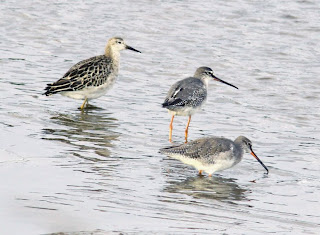We’ve pencilled in Thursday morning for a spot of ringing when the low pressure should be long gone taking the wind with it. Not so this morning when another blowy morning saw me hit the Pilling patch and birding via Fluke Hall first.
The always shy Tree Sparrows are spending lots of time waiting around in the hedgerows at the moment because both the adults and young of the year undergo a complete moult, a time when they become more vulnerable to predators. I watched a gang of about 30 of them near Fluke Hall, and then as I tried counting the sparrows I spied a young Blackcap and 3 Whitethroat flitting through the same hawthorns, with several Goldfinch and Chaffinch about too.



At Lane Ends I ducked down behind the wall and headed up to Pilling Water where hugging the tideline I counted 2 Skylark, 4 Linnet and 30 Goldfinch, and then on the marsh 3 Little Egret and 2 Grey Heron. Ravens have become fairly frequent around here in recent years, today being no exception when a single one came from the south east, and then flew to the incoming tideline where it squabbled with a Carrion Crow for a while before the big one croaked off towards Fluke Hall.
Against the stiff wind I made a few counts along the way: 28 Shelduck, 55 Curlew, 2 Wigeon, 115 Lapwing, 22 Ringed Plover and 18 Dunlin. At the wildfowler’s pools I watched about 240 Teal take flying practice when without warning whole gangs of them suddenly and with no apparent reason erupted from the water. They would head off west or south, circle around for a minute or two and then just as quickly as they left, return in tight formation with a headlong rush for the safety of the quiet, food-filled pools.

There was single male Wheatear this morning, the bird on the usual spot but almost certainly a different bird to recent days. There had been a a number of Swallows al morning, a dozen or two near Fluke, a couple at Lane Ends, but also a steady movement west along the shore that included House Martins. My morning count came to 150+ Swallow and 12 House Martin.
It was near the sea wall I settled down, hidden in the damp grass to watch the antics of a gang of local Swallows, recently fledged youngsters still relying on food from parents. Although there was no sun to enhance the Swallow’s plumage, the birds were close enough to get a few pictures. It’s almost September and these could be my last Swallow images until they return next year.




































.jpg)






































